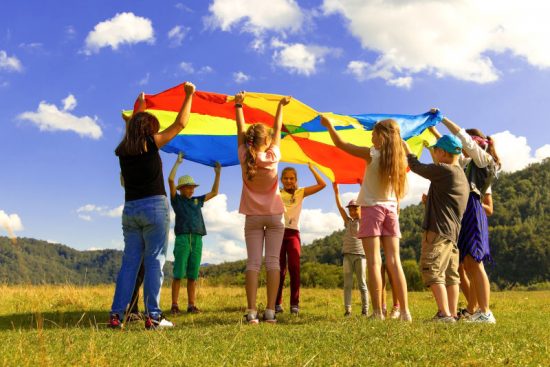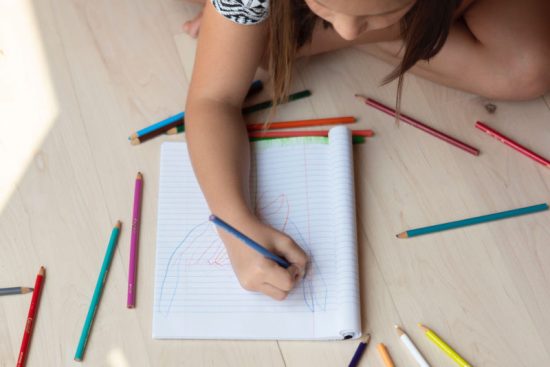This page may contain affiliate links. If you purchase something through one of the links, we may receive a commission at no extra charge to you. Still, we would include only products we actually trust and believe will be helpful for you.
“Here comes a red fire truck!”
“Where is your blue shirt?”
“Find the yellow puzzle piece.”
Several of the first words a little child will learn are color words: red, blue, yellow, green, and so on. Kids learn to name the colors and distinguish between them in a natural and ongoing way throughout their early childhood years. The more intentional parents and caregivers are in helping their children learn the colors, the quicker and deeper this learning takes place.
In this article, we share several strategies for teaching your young child the basic colors, including several fun activities to try at home or in the early childhood classroom.
Start Simple
Little kids usually do best with clear directions and simple, straightforward activities. This is true for teaching children colors, too.
Plan to start with just 2 colors at a time. Choose colors that are contrasting, or opposites, like red and green instead of red and orange, or purple and yellow instead of blue and purple.
Two contrasting colors are much easier to distinguish than two analogous colors. ‘Analogous’ is just a big word that refers to two colors that are next to each other on the color wheel.

Once you choose 2 contrasting colors, decide which toys or objects to use to make the comparison. If possible, use objects whose only difference is their color. For example: use a red block and a green block, or a yellow ball and a purple ball. This way, children see the difference is in the color and not in the toy or object.
As you show the object to your child, describe it with simple, repetitive language:
“Here is the purple ball. I have the purple ball in my hand. Can you touch the purple ball?”
“Now I have the yellow ball in my hand. The yellow ball reminds me of the sun shining outside! I like the color yellow. Would you like to hold the yellow ball?”
Use an exaggerated tone of voice for the color to draw attention to the word. This helps your child pay closer attention to it. Invite your son or daughter to hold, observe, and play with the colorful objects and encourage him or her to say the color word aloud.
When to Start Teaching Colors
Many children start to learn colors at about 18 months old, though it is important to remember that children learn at their own pace. If your child starts showing interest earlier or needs more time, that’s OK!
The Centers for Disease Control & Prevention (CDC) suggests children begin to sort by shape and color by age 2 and learn to name and distinguish between colors by age 4.
Children continue learning about colors as they go through elementary school and beyond.
Simple Activities for Learning Colors
Teaching children colors is about repetition and over-exposure. Your toddler will need many, many opportunities to see, hear, and say colors.
Show your child a wide variety of colors in picture books, toys, everyday objects, food, and art. Say the names of colors in different contexts for her to hear the color words over and over. Repetition and multi-sensory learning (e.g. seeing, hearing, touching) help children internalize these new words in a lasting way.
There are so many quick, fun, and easy activities to try with your child to help her learn the colors! Here are 8 ideas for you to try at home or in an early childhood classroom.
1. Read Books About Colors
Many children’s books have beautiful illustrations that help children learn their colors. Consider reading:
- Brown Bear, Brown Bear, What Do You See?
- A Color of His Own
- The Crayons’ Book of Colors
- Blue Hat, Green Hat
- Pete the Cat: I Love My White Shoes

2. Do Color Puzzles
Puzzles are a fun, interactive way to practice colors with your child. There are many puzzle types and options for you to choose from to help you meet the developmental needs of your toddler or preschooler. For instance, inset puzzles often have pieces that are of different colors. One piece may be mainly blue and another may be green, for example. This is helpful for younger children that are just learning to identify basic colors.
3. Go On A Color Scavenger Hunt Outside
A color scavenger hunt is simply a scavenger hunt that asks children to find items of a particular color. For example:
- Find something green (e.g. a leaf)
- Find something brown (e.g. a piece of tree bark or a stick)
You can also have a scavenger hunt inside your home or classroom, too. The benefits of making it outdoors are simply that your child will get fresh air and exercise while learning to identify colors in nature.
4. Match and Sort Toys by Color
Help your child match and sort toys of the same color.
Start by choosing one category of toys, like foam blocks, toy cars, magnetic letters, or stacking cups. Model for your child how to group toys that are the same color. Put all the red cars in one pile and all the black cars in another pile. This is an example of sorting.
Next, show your young child how to match and sort different kinds of toys that are the same color. For example, set out all the blocks, cars, and letters onto the floor. Then, have your child group all the green blocks, cars, and letters into one area and all the purple blocks, cars, and letters into another area. This skill is slightly more advanced than the first skill because your child must distinguish between both object and color.
Another way to match by color is to lay out pieces of construction paper and have your son or daughter match toys to their corresponding construction paper color. You might place a yellow ball, a yellow counting bear, and a yellow Lego on the yellow construction paper, for example. And then your daughter can try to find all the red toys to place onto the red construction paper.
5. Create Colorful Art
Art activities are a wonderful way to explore different colors.
Help your child use crayons, colored pencils, markers, and/or paint to create all sorts of bright pictures. You can have fun varying the materials your child uses, too. Try everything from construction paper and cardboard boxes to blank canvases.
Toddlers may enjoy finger painting and scribbling with crayons. This kind of art is perfect for their developmental abilities. Just make sure to reinforce the names of the colors that your child is using and encourage her to try to say the names of those colors.

6. Name the Colors of Everyday Objects
Teaching colors should be an ongoing process and not just a one-time activity. Talk with your kid about the colors that you see every day. You can try saying or asking:
- I see a red shape on the side of the road. Can you guess what I’m looking at?
- Do you know what’s the color of plates we’re using for breakfast today?
- What is your favorite color today?
- My toothbrush has pink on it. What colors does your toothbrush have?
- What is the color of grapes you had at snack time today?
- Do you think this Lego looks red or orange?
- How many colors do you see in the foods on your dinner plate?
- Which colors seem like happy colors to you?
- I see something bright purple in our garden. What do you see that is purple?
These kinds of comments and questions encourage creative thinking about colors. They invite children to look for colors throughout their environment and not just in the crayon box.
7. Play Games That Teach Colors
Many children’s toys and games naturally incorporate colors. Counting bears, Legos, wooden or foam blocks, and magnetic tiles, for example, are all color-based toys. These are great for introducing colors because the objects are the same outside of the color.
You may also try games like Candyland, Twister, Uno, or flashcards for children who are able to follow basic instructions and game rules (usually age 4 or older).
8. Host A Color Party
Color parties offer endless possibilities for creative fun! A color party can be almost anything you want it to be as long as the emphasis is on the color(s) and there is an element of celebration and joy.
Try these color party ideas:
- Color-themed mealtime: ‘Blue Breakfast’ could mean that everything on your child’s plate is blue. Serve Blueberry Cheerios with a side of blueberries, for example. Encourage the whole family to wear a blue shirt to breakfast and bring their favorite blue stuffed animal to the breakfast party.
- Color-themed dress-up: Assign everyone a different color to wear one day. You could ask the family to wear different shades of red, or different colors of the rainbow, or the colors of Christmas, or any other themed color that makes sense for your family and culture. Be sure to take pictures of the colorful fun!
- Color-themed playtime: Ask your child to choose one color for his playtime. Then, help him bring as many toys and objects of that one color to the color party. For example, if your son chooses orange, he may find his orange tiger, orange dump truck, orange puzzle pieces, and orange blocks to bring to the table. Bonus: serve an orange snack, like clementines or carrots, at the orange color party.
Extending Learning About Colors
As children make their way through elementary school, they may show readiness for enrichment activities to deepen their understanding of colors.
You may extend your child’s learning about colors by teaching:
- Advanced color vocabulary words, including hues like turquoise, burgundy, amber, and bronze
- Primary, secondary, and tertiary colors
- Warm and cool colors
- Complementary colors
- Monochromatic colors
- The color wheel (shown below)

Conclusion
A child’s world is a bright place with opportunities to find color everywhere! Helping your little one learn to recognize these colors can be an exciting and joyful experience for you both.
Teaching children the colors should be a fun, interactive, and creative process. Simple activities, like the ones we share in this article, can help you get started. Feel free to tweak them and create your own so that they fit the unique interests and abilities of your child.
These color activities also encourage other important childhood skills like fine motor development, creativity, imagination, problem-solving, and more. Enjoy teaching and learning about colors!




